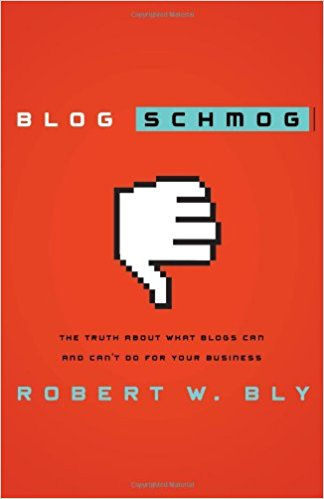Blog Shmog By Robert W. Bly

Blog Schmog by Robert W. Bly: A Deep Dive Through the Hype Machine
The mid-2000s were a heady time for the internet. A new term, “blog,” bounced around like a beach ball at a crowded pool party. Everyone seemed to be starting one, businesses included. The promise? A magic bullet for marketing and PR. Robert W. Bly, a seasoned writer and marketing consultant, saw things differently.
He entered the conversation with a book titled Blog Schmog: The Truth About What Blogs Can (and Can’t) Do For Your Business. Published in 2006, it was a much-needed dose of skepticism amidst the overwhelming hype.
Bly wasn’t a blogging naysayer. Instead, as he described in an interview with AllBusiness.com [AllBusiness Interview with Robert Bly], he aimed to provide a “second opinion.” Blog Schmog wasn’t a book designed to bash blogs, but rather to dissect the phenomenon, analyze its impact on various fields, and offer a balanced perspective.
Dissecting the Blogosphere: Hype vs. Reality

The early days of blogging were a whirlwind of inflated expectations. Businesses were bombarded with messages about blogs being the ultimate marketing and PR tool. Bly cuts through this noise by examining the limitations of blogs head-on. Here are some key points he explores:
- The Challenge of Audience Acquisition and Retention: Building a loyal readership is tough. It requires consistent, high-quality content that resonates with your target audience. Blogs with shallow or unoriginal content will struggle to attract and retain readers in the long run.
- The ROI Enigma: Measuring the return on investment (ROI) of a blog can be tricky. While brand awareness and thought leadership can be valuable outcomes, quantifying their impact on the bottom line can be challenging.
- The Double-Edged Sword of Comments: Blog comments can be a great way to engage with readers and foster a community. However, they can also be a breeding ground for negativity and criticism. Businesses need to be prepared to manage comments effectively to avoid potential damage to their reputation.
Navigating the Blogosphere:
Bly delves deeper into the inner workings of the “blogosphere,” the interconnected web of blogs. He explores concepts like:
- Blogging Evangelists: Enthusiastic bloggers who tirelessly promote the platform, often with an overly rosy picture of its capabilities.
- Echo Chambers and Filter Bubbles: The tendency of people to gravitate towards blogs that reinforce their existing beliefs, creating a self-reinforcing system where they are rarely exposed to opposing viewpoints.
Understanding these dynamics is crucial for businesses looking to leverage blogs effectively.
Building a Blog That Works
Despite highlighting the limitations, Bly recognizes the potential of blogs. He dedicates a significant portion of the book to practical advice on starting and maintaining a successful blog. Here are some key takeaways:
- Content is King: This timeless principle reigns supreme. Creating valuable, informative, and engaging content is essential to attracting and retaining readers. Bly offers tips on identifying your target audience, crafting compelling headlines, and developing a consistent content calendar.
- Embrace Storytelling: People connect with stories. Bly encourages incorporating storytelling techniques into your blog posts to make them more engaging and memorable.
- Optimize for Search Engines (SEO): Bly recognizes the importance of search engine visibility for blogs. He provides basic SEO tips to help businesses improve their blog’s ranking in search engine results pages (SERPs).
- Community Building: Blogs are a powerful tool for building relationships and fostering a community around your brand. Bly offers insights on how to encourage reader engagement through comments, forums, and social media integration.
Blogging for Business: Beyond the Hype
A significant portion of the book focuses on the role of blogs in business communication. Bly goes beyond the “magic bullet” mentality and advises businesses to carefully consider their goals before jumping on the blogging bandwagon. Here are some key points he emphasizes:
- Align with Your Overall Marketing Strategy: Your blog should be an integral part of your overall marketing strategy, not a standalone entity.
- Identify Your Target Audience: Who are you trying to reach with your blog? Understanding your target audience is essential for crafting content that resonates with them.
- Commitment is Key: Blogging requires a consistent commitment of time and resources. Are you prepared to invest in creating high-quality content on a regular basis?
- Measure and Adapt: Track your blog’s performance and analyze what’s working and what’s not. Be prepared to adapt your strategy based on the data you gather.
Beyond the Hype: The Enduring Questions
The book concludes by looking ahead at the future of blogging. While the landscape has dramatically changed since 2006 with the rise of social media platforms like Facebook, Twitter, and YouTube, the dominance of blogs as a communication channel has waned.
However, the core questions Bly raises about the long-term viability of online content creation and the challenges of maintaining audience engagement remain relevant.
Is Blog Schmog Still Relevant Today?
The digital landscape of the mid-2000s may seem like a distant memory, but Blog Schmog by Robert W. Bly offers valuable insights that transcend the era of standalone blogs. Here’s why this book remains a worthwhile read in today’s social media-driven world:
- Combating the Hype Machine: The book serves as a healthy antidote to the relentless hype surrounding the “next big thing” in marketing and communication. It encourages businesses to take a measured approach when evaluating new online tools and platforms.
- Focus on Strategy Over Tactics: Social media platforms come and go, but the importance of having a clear and well-defined strategy for your online presence remains constant. Bly emphasizes the need to understand your target audience, define your goals, and develop a content strategy that aligns with your overall marketing objectives.
- Content is Still King: The core message of Blog Schmog – that attracting and retaining readers requires valuable content – holds true even in the age of social media. Bly’s advice on content creation, storytelling, and understanding your audience is as relevant as ever for crafting social media posts, video content, or any other form of online communication.
- The Evolving Online Ecosystem: While the specifics of the blogosphere may have changed, the core dynamics of online communities remain similar. Understanding how people consume information online, how echo chambers form, and how to build online communities are all essential aspects of navigating the complexities of social media marketing.
Blog Schmog in the Age of Social Media
Bly may not have anticipated the rise of social media giants like Facebook and Twitter, but the principles he explores in Blog Schmog can be effectively applied to these platforms as well. Here’s a brief look at how some of his key takeaways translate to the social media landscape:
- Building Communities: Social media platforms offer powerful tools for building communities around your brand. Bly’s emphasis on fostering reader engagement through comments and discussions translates directly to social media interactions, likes, and shares.
- The Power of Storytelling: Social media thrives on stories. Just as Bly advocated for incorporating storytelling into blog posts, social media posts that leverage narratives and evoke emotions are more likely to resonate with audiences.
- The Importance of Measurement: Bly highlights the importance of measuring the performance of your blog. This principle applies equally to social media marketing. Businesses need to track key metrics such as engagement, reach, and click-through rates to understand what’s working and what needs improvement.
- Adaptability is Key: The social media landscape is constantly evolving. New platforms emerge, algorithms change, and user behaviors shift. Just as Bly advised bloggers to adapt their strategies based on data and feedback, businesses need to be adaptable in their social media marketing approach.
Final Word
While the world of online communication has evolved significantly since the mid-2000s, Robert W. Bly’s Blog Schmog remains a valuable resource for anyone navigating the ever-changing digital landscape.
Its core message – that effective online communication requires a strategic approach, valuable content, and a deep understanding of your audience – holds true regardless of the specific platform you’re using.
Whether you’re a blogger, a social media manager, or a business owner looking to establish an online presence, Blog Schmog offers a thought-provoking and practical perspective that can help you navigate the complexities of the online world and achieve your communication goals.













